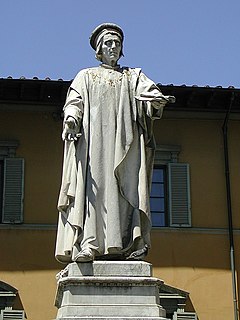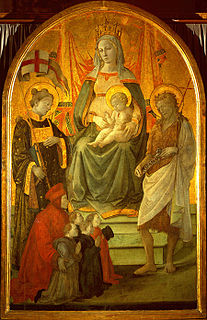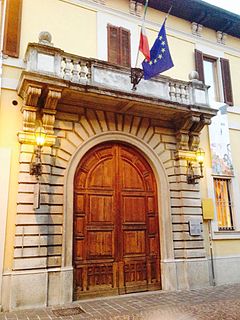
Mantua is a city and comune in Lombardy, Italy, and capital of the province of the same name.

Ascoli PicenoItalian: [ˈaskoli piˈtʃɛːno](listen); Latin: Asculum) is a town and comune in the Marche region of Italy, capital of the province of the same name. Its population is around 47,000 but the urban area of the city has more than 93,000.

Grosseto is a city and comune in the central Italian region of Tuscany, the capital of the Province of Grosseto. The city lies 14 kilometres from the Tyrrhenian Sea, in the Maremma, at the centre of an alluvial plain on the Ombrone river.

The Palazzo Pitti, in English sometimes called the Pitti Palace, is a vast, mainly Renaissance, palace in Florence, Italy. It is situated on the south side of the River Arno, a short distance from the Ponte Vecchio. The core of the present palazzo dates from 1458 and was originally the town residence of Luca Pitti, an ambitious Florentine banker.

Casa Rocca Piccola is a 16th-century palace in Malta, and home of the noble Maltese family de Piro. It is situated in Valletta, the capital city of Malta. There are daily tours from 10am till 5pm. The palace includes a restaurant called La Giara Restaurant.

Prato is a city and comune in Tuscany, Italy, the capital of the Province of Prato. The city lies 17 kilometres north-west of Florence, at the foot of Monte Retaia, elevation 768 metres (2,520 ft), the last peak in the Calvana chain. With more than 195,000 inhabitants, Prato is Tuscany's second largest city and the third largest in Central Italy.

The Palazzo Barberini is a 17th-century palace in Rome, facing the Piazza Barberini in Rione Trevi. Today it houses the Galleria Nazionale d'Arte Antica, the main national collection of older paintings in Rome.

Palazzo Schifanoia is a Renaissance palace in Ferrara, Emilia-Romagna (Italy) built for the Este family. The name "Schifanoia" is thought to originate from "schivar la noia" meaning literally to "escape from boredom" which describes accurately the original intention of the palazzo and the other villas in close proximity where the Este court relaxed. The highlights of its decorations are the allegorical frescoes with details in tempera by or after Francesco del Cossa and Cosmè Tura, executed ca 1469–70, a unique survival of their time.

Poggio a Caiano is a town and comune in the province of Prato, Tuscany region Italy. The town, birthplace of Philip Mazzei, lies 9 kilometres (6 mi) south of the provincial capital of Prato.

Francesco di Marco Datini was an Italian merchant born in Prato. Datini is notable for having implemented the first partnership system in business in 1383.

The Museum of the Risorgimento, located in the 18th-century Milanese Palazzo Moriggia, houses a collection of objects and artworks which illustrate the history of Italian unification from Napoleon's first Italian campaign of 1796 to the annexation of Rome in 1870. The city of Milan played a key role in the process, most notably on the occasion of the 1848 uprising against the Austrians known as the Five Days of Milan.

The Madonna del Ceppo is a painting by the Italian Renaissance painter Filippo Lippi, commissioned to him between 1452 and 1453. It is housed in the Civic Museum of Prato, Italy. The name derives from the fact that it was located over a pit of the garden of Pia Casa dei Ceppi in Palazzo Datini, in Prato.

The Messina Palace, also known as Palazzo Messina, is a palace located at No 141 and 141A Strada San Cristoforo in Valletta, Malta. It was built by Fra Pietro La Rocca, Prior of Santo Stefano, towards the end of the 16th century and was once part of a grander palace called Casa Rocca Grande. The property has been occupied by the German-Maltese Circle since 1975, who purchased the building from the Stilon family in 1989.

The Palazzo Pretorio is a historical building in Prato, Tuscany, italy. It was the old city hall, standing in front of the current Palazzo Comunale. It now accommodates the Civic Museum of Prato, which was reopened on September 2013.

The Palazzo Cusani is a palace at Piazzale San Francesco #1 in the central Parma region of Emilia-Romagna, Italy.

The Palazzo Ghirlanda-Silva is a patrician building in the old town of Brugherio, Italy. Built in the first half of the nineteenth century, it now houses the public library. It has an area of 1,992 m2 (21,440 sq ft), of which 1,407 m2 (15,140 sq ft) are used for library services, with the remaining space providing an exhibition room, an auditorium and offices.

Palazzo Parisio, sometimes known as Casa Parisio, is a palace in Valletta, Malta. It was built in the 1740s by Domenico Sceberras, and eventually passed into the hands of the Muscati and Parisio Muscati families. It was Napoleon's residence for six days in June 1798, during the early days of the French occupation of Malta. The palace was eventually acquired by the de Piro family, and was later purchased by the Government of Malta. It was used as the General Post Office from 1886 to 1973, then the Ministry for Agriculture, and it now houses the Ministry for Foreign Affairs.

Palazzo Nasciaro is an 18th-century townhouse in Naxxar, Malta, built during the Order of St. John. The townhouse was originally built as a family home, but has undergone adaptive reuse several times to fit the changing needs of the local population.
The following is a timeline of the history of the city of Prato in the Tuscany region of Italy.

The Episcopal Palace is a building located in Piazza Mino of Fiesole, Italy. Built in the eleventh century, it serves as the residence of the Bishop of Fiesole.





















